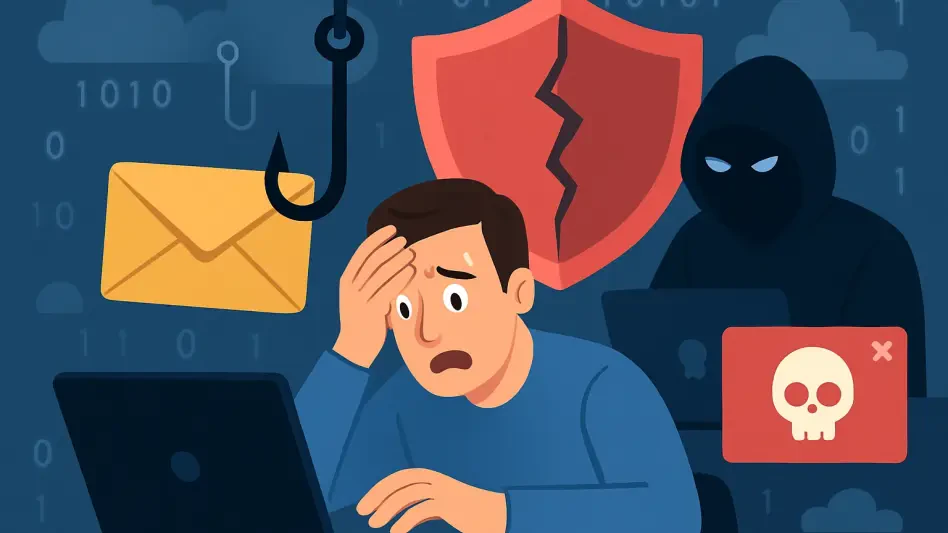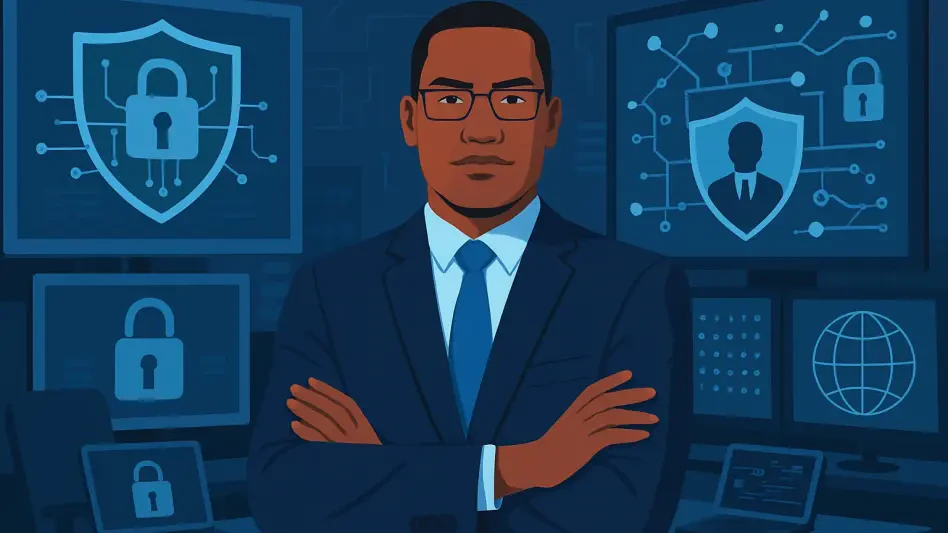In an era where digital threats loom larger than ever, phishing scams stand out as a particularly insidious danger, deceiving employees into surrendering sensitive information like passwords or personal data through cunningly crafted emails. Despite the widespread adoption of cybersecurity training programs aimed at equipping staff to recognize and resist these attacks, a recent study conducted at UC San Diego Health with over 19,500 participants over eight months delivers a sobering revelation: these initiatives are falling short. The research paints a stark picture of ineffective strategies that fail to curb the rising tide of phishing success. This article delves into the critical insights unearthed by the study, examining why traditional training methods are not delivering the expected protection and exploring what alternatives might hold the key to safeguarding organizations. As phishing continues to be a leading cause of data breaches, understanding these shortcomings is not just timely but essential for any sector handling sensitive information.
Unmasking the Ineffectiveness of Current Training Methods
The comprehensive study at UC San Diego Health set out to evaluate two widely used cybersecurity training approaches: annual mandated training, a staple in many organizations, and embedded phishing training, which provides education immediately after an employee interacts with a simulated phishing email. The results were disheartening, showing that neither method made a significant dent in reducing the likelihood of employees clicking on malicious links. Annual training demonstrated no discernible link to lower click rates, suggesting that the once-a-year refresher courses fail to instill lasting awareness or behavioral change. Embedded training, often touted as a more interactive solution, achieved only a marginal 2% reduction in susceptibility. Given the substantial time, effort, and financial resources poured into rolling out these programs across large workforces, such negligible improvement raises serious questions about their value as a frontline defense against phishing threats in today’s fast-evolving digital landscape.
Further compounding the issue is the evident lack of engagement with the training content itself. Data from the study revealed that a staggering 75% of participants spent less than a minute reviewing embedded training materials, while a full third dismissed the content entirely by closing the page without any interaction. This widespread disinterest points to a fundamental flaw in the design and delivery of these programs. If employees are not absorbing the lessons or finding the material compelling enough to warrant attention, the training becomes little more than a procedural checkbox rather than a meaningful tool for building resilience. The format often feels detached from real-world scenarios or fails to connect with the daily experiences of staff, leaving them ill-prepared to identify sophisticated phishing attempts. This disconnect highlights an urgent need to rethink how educational efforts are structured, pushing for methods that can capture interest and drive home the gravity of cyber risks in a more impactful way.
Escalating Risks Over Time
One of the most alarming findings from the UC San Diego Health research is the trend of increasing vulnerability among employees as the study progressed. In the initial month of the experiment, just 10% of participants fell for phishing links, a figure that might suggest a baseline level of caution or awareness. However, by the eighth month, this number had surged dramatically, with over half of the employees having clicked on at least one deceptive link. This trajectory indicates that repeated exposure to phishing simulations, rather than sharpening defenses, may actually erode vigilance. Employees could be developing a sense of complacency, assuming they’ve seen it all, or becoming desensitized to warnings through overfamiliarity with test scenarios. Such a pattern underscores a critical flaw in relying solely on repetitive training or simulation exercises as a protective measure, suggesting that without fresh and dynamic approaches, these efforts might inadvertently heighten risk rather than mitigate it.
Beyond the raw numbers, this rising susceptibility reflects deeper challenges in maintaining long-term alertness in a workforce. As phishing attempts become more frequent and sophisticated, employees face a barrage of potential threats that can blur the line between genuine and malicious communications. The study’s findings suggest that current training does little to counter this fatigue, failing to adapt to the evolving nature of attacks or to reinforce the importance of sustained caution over extended periods. Without mechanisms to refresh engagement or introduce new learning strategies, staff may grow numb to the dangers, treating alerts as routine rather than urgent. This growing vulnerability serves as a stark reminder that cybersecurity is not a one-time fix but a continuous battle requiring innovative solutions to keep pace with both technological advancements and human behavioral tendencies that attackers exploit with increasing precision.
The Danger of Customized Phishing Lures
Phishing attacks are not created equal, and the UC San Diego Health study sheds light on how tailored deception significantly amplifies their success. The research found stark variations in click rates depending on the nature of the lure used in simulated emails. For instance, only 1.82% of employees clicked on a link prompting an Outlook password update, a relatively low figure that might reflect some inherent skepticism about such requests. In sharp contrast, a staggering 30.8% engaged with a message tied to a vacation policy update, a topic likely to resonate more personally or seem less suspicious in a workplace context. This wide disparity reveals how attackers can dramatically boost their odds by crafting emails that tap into specific interests, roles, or current events relevant to their targets, often rendering even well-intentioned training ineffective against such personalized threats that exploit human curiosity or urgency.
This insight into the power of context-specific phishing underscores a critical limitation of generic training programs. Most cybersecurity education focuses on broad warning signs—such as suspicious links or unfamiliar senders—without delving into the nuanced ways attackers tailor their approaches to blend seamlessly into an employee’s daily routine. When a phishing email mimics internal communications or references timely organizational updates, it bypasses the mental red flags that training attempts to instill. The significant success rate of certain lures suggests that employees are not equipped to scrutinize messages that appear relevant or authoritative, no matter how much awareness has been raised. Addressing this gap calls for a shift in focus, perhaps integrating real-world examples into training or emphasizing critical thinking skills over rote recognition of phishing hallmarks, to better prepare staff for the cunning adaptability of modern cyber threats.
Shifting Focus to Technical Safeguards
Given the clear shortcomings of traditional training, the researchers behind the UC San Diego Health study advocate for a fundamental pivot toward technical solutions that minimize reliance on human behavior. Tools such as two-factor authentication (2FA) for both hardware and applications stand out as a robust barrier, adding an extra layer of security that can thwart unauthorized access even if credentials are compromised. Similarly, password managers configured to operate exclusively on verified domains offer a practical way to prevent employees from inadvertently entering sensitive information on fraudulent sites. These measures target the root causes of phishing success—stolen credentials and unauthorized entry—delivering a far more effective return on investment compared to training programs that yield minimal impact, as evidenced by the study’s marginal improvements in click rate reductions.
Adopting technical defenses also addresses the inherent unpredictability of human error, which no amount of education seems to fully eliminate. Unlike training, which depends on consistent engagement and retention of information, solutions like 2FA function independently of an employee’s awareness or attention on any given day. This approach aligns with broader industry trends recognizing that phishing, identified as the leading cause of breaches in a 2023 IBM report with 16% of successful attacks, demands systemic rather than individual countermeasures. By embedding security into the infrastructure—through automated authentication protocols or domain-specific safeguards—organizations can create a more resilient shield against deception. The shift represents not just a tactical change but a philosophical one, acknowledging that while awareness remains important, it cannot bear the full burden of protection in an era of increasingly sophisticated cyber threats.
High Stakes in Critical Sectors
The setting of the UC San Diego Health study in the healthcare sector amplifies the urgency of rethinking cybersecurity strategies. With over 725 large data breaches and 133 million compromised health records reported in 2023 by the U.S. Department of Health and Human Services, the consequences of phishing in this field are nothing short of catastrophic. Patient data, often including highly sensitive personal and medical information, becomes a prime target for attackers, with breaches leading to financial loss, legal repercussions, and profound erosion of trust. The failure of training programs to protect employees in such a high-stakes environment reveals a glaring vulnerability, where a single click can unleash devastating ripple effects across an entire system, compromising not just organizational integrity but also individual lives dependent on secure care.
This context of heightened risk in healthcare serves as a microcosm for other industries handling sensitive data, from finance to government. The study’s findings suggest that sectors with similarly critical stakes cannot afford to lean on ineffective training as their primary defense. The sheer scale of potential damage—both in terms of data loss and reputational harm—demands immediate action to implement stronger safeguards. While healthcare’s unique regulatory and ethical pressures add layers of complexity, the core lesson applies universally: phishing’s persistence as a threat requires solutions that transcend human fallibility. Prioritizing technical barriers over educational efforts could mean the difference between a contained incident and a full-scale crisis, urging leaders in all fields to reassess their strategies with the same sense of gravity that healthcare demands in protecting its most vulnerable stakeholders.
Charting a Path Forward with Robust Defenses
Reflecting on the UC San Diego Health study, it becomes evident that past reliance on cybersecurity training as a primary bulwark against phishing scams was misplaced. The research laid bare the stark reality that neither annual nor embedded training significantly curbed employee susceptibility, with engagement levels dismal and vulnerability rising over time. Tailored phishing lures further exposed the inadequacy of generic awareness campaigns in countering sophisticated deception. These findings, observed across a vast sample of over 19,500 participants, compelled a reevaluation of defensive priorities in industries where data security is paramount.
Looking ahead, the path forward hinges on embracing technical solutions that outmaneuver phishing at its core. Organizations must invest in mechanisms like two-factor authentication and domain-verified password managers, which proved more promising than training in thwarting unauthorized access. Beyond immediate implementation, fostering a culture of continuous adaptation—through regular updates to security protocols and integration of emerging technologies—can ensure defenses evolve alongside threats. This strategic shift, grounded in the lessons of extensive research, offers a pragmatic blueprint for safeguarding sensitive information in an increasingly perilous digital landscape.








